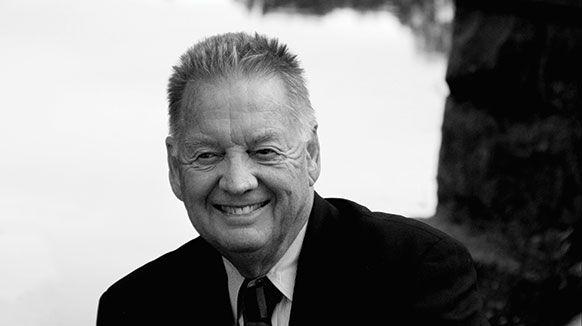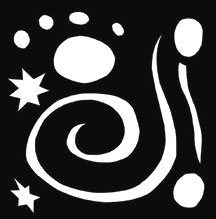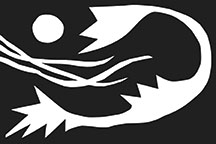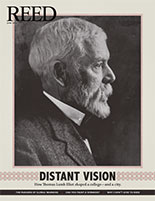
IRIS login | Reed College home Volume 93, No. 2: June 2014
Poet || Artist

Photo by Robin Damstra Salant
Jim Haba ’62 is equally at home on the blank page and the blank canvas.
By laurie Lindquist

 cut outs by Jim Haba
cut outs by Jim HabaYou could say that Jim Haba is a man of many words. An established poet, professor of English and world literature, and founding director of the Geraldine R. Dodge Poetry Festival—the nation’s largest poetry event—he has earned national recognition for his literary work.
Recently, however, we were surprised to learn that while directing the festival, the Dodge Poetry-in-the-Schools Program (1986–2008), and teaching at Glassboro/Rowan University (1972–2003), Jim sustained a “parallel life” as a visual artist.
Poetry was Jim’s first love, but he wrote very little during his time at Reed, with the exception of work done for a class with Prof. Ken Hanson [1954–86]. And though he and classmate Larry McKenzie served as 1962 coeditors of the Reed literary magazine Ursus, he did not publish any of his own work.
At both Rutgers University, where he taught English (1966–72) and at Glassboro/Rowan, he supported poetry by arranging readings and workshops by accomplished poets, “which finally led in 1975 to finding ways to write my own poems,” he says. Over the next decade, Jim won several poetry prizes and was awarded the New Jersey State Council of the Arts Fellowship in Poetry in 1985.
A year later, he directed the first Dodge Poetry Festival, “knowing that the scale of the project would almost certainly require that my own work take a back seat.” But the writing continued, scaled down to a handful of pieces per year for two decades, while the festival blossomed into a major cultural event, earning him the 2000 Betty Kray Award from Poets House for service to the field of poetry and the 2011 Paterson Literary Review Award for lifetime service to literature.
In 2006, Jim designed and printed two chapbooks of his own work, 31 Poems and Love Poems. “I am happy with my poems, would be lonely without them, and regard them as natural complements to my paintings.”
His study of studio art began at Douglass College, while he was teaching at Rutgers and had completed a PhD in English from Cornell University. In 1968–70, he studied drawing and sculpture in evening and summer classes at the Studio School in New York City, and in 1975, he mounted his first solo show of paintings in Princeton.
Sharing a studio with his wife, Erica Barton Haba, a tile muralist, he designed and produced his own ceramic tile murals in 1984–2004, commissioned and sold through major tile stores in Boston and New York City. “My tile mural designs derived from earlier work with black and white paper cutouts and these designs always featured pure colors on a white background, or the reverse.”
In the mid-’90s, he began experimenting with larger collages on painted paper, incorporating an increasingly broad range of colors and featuring “lots of application texture.” Papers were cut, assembled, and glued together to form each painting. These preliminary collages formed the basis of a body of work that continues to evolve and mature.
Last summer, Jim and Erica mounted two shows of paintings—the first at Passaic County Community College in Paterson, New Jersey, and the second at Aljira: A Center for Contemporary Art in Newark. In December 2013, he finished a new series of 10 large paintings, Music/Dance.
Jim says that he is grateful to Reed for deepening his experience of intellectual rigor and contributing to his growing awareness of history and context. “Significant contributions to anyone’s maturation,” he says, though he also yearned for something less rational and more rooted in imagination during those years.
“Having come to Reed intent on acquiring what I knew it had to offer, and after largely succeeding in that acquisition, I still found that only after I had obtained the PhD, our standard intellectual credential, could I finally begin to allow myself to discover what that ‘something else’ I had yearned for might be. Only then could I start to fill out the life that has subsequently brought me some fortunate success and much personal gratification.
“I have happily followed the development of the broader and more stimulating art-making culture that seems such a part of Reed’s current campus life and often wonder how I might have been able to benefit from such imaginative richness during my own student days.”
Listen, Friends
We live like barnacles clinging to rocks
swept night and day by tides of love.
Let’s not waste time asking if war is ever good.
With each flood curiosity, desire, ecstatic action.
With each ebb suspicion, dread, armored solitude.
What stands between us and what we want?
What could we want except to live as love,
fluid and in motion, unafraid and eternal?
Listen, Friends, this drunkenness needs no wine.
When did we last kiss as if it were our last kiss?
Coming Home
As I cross the Outerbridge and angle north,
smoothly passing back into New Jersey,
with the low sun filling the sky on my left,
and a thin, flat cowboy’s song on the radio,
I think again of Homer
and of Helen, so beautiful
that he describes her only as “shining,”
his way of talking about God;
strange divinity indeed.
An empty vessel, and in the emptiness
value itself, and also
utter shame, utter worthlessness:
Helen, the natural and permanent queen,
Helen, the hopeless slut.
And how Homer loved her!
Seeing
her beauty, her emptiness, her despair,
and his love,
I also see
that this road under my wheels
is holy,
that the cement divider curving beautifully beside me
is holy,
conceived and built with such care,
the ordered line of bright green rebar arches
successively covered by the single steel form,
all the hands at work,
the bodies applied,
the minds dedicated,
sighting, measuring, adjusting,
all full now of western light
in which I see that the steering wheel
is holy,
that the voice on the radio
is holy,
and my own hands,
holy.
I could be losing my mind or
maybe my mind is just breaking free but
I believe I am driving
into the space between my ideas
and nothing I ever did in my life
has been this easy.
Go Further
View the full scope of Jim’s work.

LATEST COMMENTS
steve-jobs-1976 I knew Steve Jobs when he was on the second floor of Quincy. (Fall...
Utnapishtim - 2 weeks ago
Prof. Mason Drukman [political science 1964–70] This is gold, pure gold. God bless, Prof. Drukman.
puredog - 1 month ago
virginia-davis-1965 Such a good friend & compatriot in the day of Satyricon...
czarchasm - 4 months ago
John Peara Baba 1990 John died of a broken heart from losing his mom and then his...
kodachrome - 7 months ago
Carol Sawyer 1962 Who wrote this obit? I'm writing something about Carol Sawyer...
MsLaurie Pepper - 8 months ago
William W. Wissman MAT 1969 ...and THREE sisters. Sabra, the oldest, Mary, the middle, and...
riclf - 10 months ago